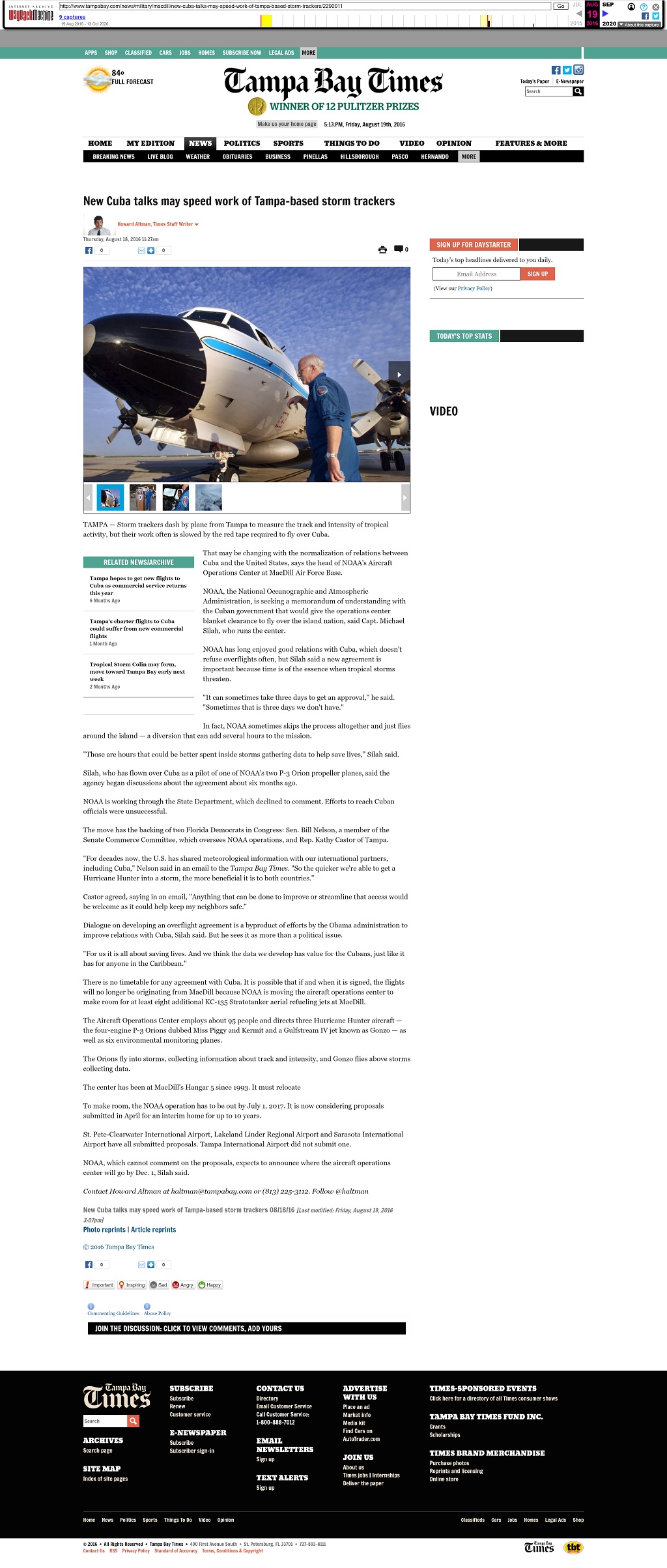
News / Military
By Howard Altman / Tampa Bay Times / August 18, 2016
PHOTO: A flight engineer prepares the P-3 Orion aircraft dubbed Kermit for a trip into the eye of a hurricane. New talks with Cuba may help speed the time it takes to reach a storm from the National Oceanographc and Atmospheric Administration center in Tampa. (Skip O’Rourke | Times 2004)
TAMPA — Storm trackers dash by plane from Tampa to measure the track and intensity of tropical activity, but their work often is slowed by the red tape required to fly over Cuba.
That may be changing with the normalization of relations between Cuba and the United States, says the head of NOAA’s Aircraft Operations Center at MacDill Air Force Base.
NOAA, the National Oceanographic and Atmospheric Administration, is seeking a memorandum of understanding with the Cuban government that would give the operations center blanket clearance to fly over the island nation, said Capt. Michael Silah, who runs the center.
NOAA has long enjoyed good relations with Cuba, which doesn’t refuse overflights often, but Silah said a new agreement is important because time is of the essence when tropical storms threaten.
“It can sometimes take three days to get an approval,” he said. “Sometimes that is three days we don’t have.”
In fact, NOAA sometimes skips the process altogether and just flies around the island — a diversion that can add several hours to the mission.
“Those are hours that could be better spent inside storms gathering data to help save lives,” Silah said.
Silah, who has flown over Cuba as a pilot of one of NOAA’s two P-3 Orion propeller planes, said the agency began discussions about the agreement about six months ago.
NOAA is working through the State Department, which declined to comment. Efforts to reach Cuban officials were unsuccessful.
The move has the backing of two Florida Democrats in Congress: Sen. Bill Nelson, a member of the Senate Commerce Committee, which oversees NOAA operations, and Rep. Kathy Castor of Tampa.
“For decades now, the U.S. has shared meteorological information with our international partners, including Cuba,” Nelson said in an email to the Tampa Bay Times. “So the quicker we’re able to get a Hurricane Hunter into a storm, the more beneficial it is to both countries.”
Castor agreed, saying in an email, “Anything that can be done to improve or streamline that access would be welcome as it could help keep my neighbors safe.”
Dialogue on developing an overflight agreement is a byproduct of efforts by the Obama administration to improve relations with Cuba, Silah said. But he sees it as more than a political issue.
“For us it is all about saving lives. And we think the data we develop has value for the Cubans, just like it has for anyone in the Caribbean.”
There is no timetable for any agreement with Cuba. It is possible that if and when it is signed, the flights will no longer be originating from MacDill because NOAA is moving the aircraft operations center to make room for at least eight additional KC-135 Stratotanker aerial refueling jets at MacDill.
The Aircraft Operations Center employs about 95 people and directs three Hurricane Hunter aircraft — the four-engine P-3 Orions dubbed Miss Piggy and Kermit and a Gulfstream IV jet known as Gonzo — as well as six environmental monitoring planes.
The Orions fly into storms, collecting information about track and intensity, and Gonzo flies above storms collecting data.
The center has been at MacDill’s Hangar 5 since 1993. It must relocate
To make room, the NOAA operation has to be out by July 1, 2017. It is now considering proposals submitted in April for an interim home for up to 10 years.
St. Pete-Clearwater International Airport, Lakeland Linder Regional Airport and Sarasota International Airport have all submitted proposals. Tampa International Airport did not submit one.
NOAA, which cannot comment on the proposals, expects to announce where the aircraft operations center will go by Dec. 1, Silah said.
- Photo 2: Hurricane Hunter aircraft belonging to the National Oceanic and Atmospheric Administration are now housed at MacDill Air Force Base, where Sen. Bill Nelson, center, discussed the future of the program in March 2015. With him are Air Force Col. Dan Tulley, left, and NOAA Col. Mike Silah. (OCTAVIO JONES | Times)
- Photo 3: Capt. Michael Silah, who now runs the NOAA Air Operations Center at MacDill Air Force Base, was a pilot for the center, helping fly a tracking plane into Hurricane Ivan, when this photo was taken in 2004. (Skip O’Rourke | Times 2004)
- Photo 4: A P-3 Hurricane Hunter aircraft based at MacDill AFB flies into the calm eye of Hurricane Ivan as the storm passes over the Cayman Islands in this 2004 photo. (Skip O’Rourke | Times 2004)
Wayback image

